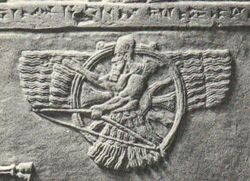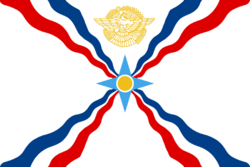Religion:Ashur (god)
| Ashur | |
|---|---|
 A Neo-Assyrian sun disk traditionally viewed to symbolize Ashur | |
| Other names |
|
| Major cult center | Assur, Uruk (6th century BC) |
| Consort | Mullissu, possibly Šerua |
| Offspring | Ninurta, possibly Šerua |
Ashur, Ashshur, also spelled Ašur, Aššur (Sumerian: 𒀭𒊹 AN.ŠAR₂, Assyrian cuneiform: 25px17px Script error: The function "transl" does not exist., 25px13px18px35px Script error: The function "transl" does not exist.)[1] was the national god of the Assyrians in ancient time until their gradual conversion to Christianity between the 1st and 5th centuries AD.
History
Ashur was the "city god" of the eponymous Mesopotamian city of Assur founded circa 2600 BC, and was frequently interchanged in Old Assyrian texts.[2] Since the city of Assur was situated upon a natural hill, Ashur may have been the deified hill,[3] and subsequent Old Assyrian names that invoke Ashur's relationship with mountains do suggest that he was originally a "mountain god".[4] Several things separate Ashur from the gods of Southern Mesopotamia and other gods of Assyria which are mostly identical to those of southern Mesopotamia (Ishtar, Sin, Adad, Shamash, Enlil etc), such as the fact that he did not originally have a family or any attributes, being solely connected to his city.[2] A bull frequently appears in Old Assyrian seals, appearing to be worshipped, suggesting that the bull was either the symbol of Ashur or was Ashur himself.[5][4] The rulers of Assur were only called the "governors" (išši'akum) of Assur, reserving the title of king for the god. A similar system was also attested in the nearby state of Eshnunna, with the human king as the governor and Tishpak taking on titles usually ascribed to kings.[6] As a general rule, Ashur was not originally worshiped outside of the city of Assur during the Bronze Age, except in some of the Assyrian trading colonies (karum) in Anatolia and nearby Assyrian towns in Upper Mesopotamia.[4]
When Shamshi-Adad I usurped the throne of Assur, he brought with him an increased level of southern influences. Shamshi-Adad renovated the temple of the god Ashur and called it Enlil's temple, equating Ashur with Enlil.[7] This equation would become significant from the Middle Assyrian Empire (1365-1050 BC) onwards, and Ashur would absorb Enlil's family, including his wife Ninlil (Mullissu) and his son Ninurta, the latter of which became an important god in Assyria [2]
During the Middle Assyrian Empire, Tukulti-Ninurta I made the unprecedented move regarding the cult of Ashur. Kar-Tukulti-Ninurta, a new royal residence north-east of Assur named after the king himself, would contain a new temple dedicated to Ashur.[8] The city was largely abandoned after his death. Assur would remain the only cult center of the god Ashur until the fall of the Assyrian empire, and indeed until the late 3rd century AD sacking of Assur by the Sassanid Empire, although Ashur was worshipped throughout Upper Mesopotamia.
With the development of the territorial and imperial state of Assyria, Ashur was also transformed from a "local god" to a "national god". Ashur was conceptualized as the father of the gods. He was essential to Assyrian imperial ideology, with the King, the representative of Ashur, being expected to fulfill the divine mandate and expand the lands of Assyria as reflecting Ashur's universal rule.[6] The close link between the Assyrian king and the god Ashur was reflected in the coronation ceremony which was performed in the temple of the god in the city of Assur, and the King was said to be the mirror image of Ashur.[9]
Starting from the reign of Sargon II, Ashur was occasionally written as Anshar, the Primordial god in the Babylonian Enuma Elish that gave birth to Anu along with Kishar. After Sennacherib's destruction of Babylon in 689 BCE, Assyrian scribes fashioned a new version of Enuma Elish that exalted Ashur instead of Marduk.[10] Ashur continued to be revered as Anshar in Neo-Babylonian Uruk after the collapse of the Assyrian Empire, where a temple to Ashur was built under the name of Anshar, breaking the tradition that Ashur's only cult place would be the city of Assur.[11]
Representation and symbolism
In the Old Assyrian Period, many seals included a worshiped bull, indicating that it was either the symbol of Ashur or depicted Ashur himself. The Neo-Assyrian winged disk is also seen as a symbol for Ashur, although reservations exist, with some arguing that it represents the Assyrian-Babylonian god Shamash instead.[4]
Ashur is attested in theophoric names starting from the Old Assyrian period down to Neo- and Late Babylonian periods, and in Assyria itself into the Sassanid Empire.[12] Considering that Ashur was a quintessential Assyrian god, this may be used as an ethnic marker. Ashur is also attested in theophoric names in Hatran Aramaic and in Parthian dominated Asoristan.[13]
Assyrian Christianity
With the expansion of Christianity, a syncretization occurred in which Assur became the Assyrian name of Christ and the solar disk on which it is represented became the shield of the Christian Assyrians, which was seen carried by Assyrian militiamen during the Syrian civil war.
See also
- Assyria
- Assyrian people
- Mesopotamian religion
- Assur
- Ahura Mazda
- Anshar
- Ashur (Bible)
- Farr-e Kiyani (Faravahar)
- Yahweh
References
- ↑ "Sumerian dictionary entry Aššur [1 (DN)"]. http://oracc.iaas.upenn.edu/epsd2/cbd/sux/A.html.
- ↑ 2.0 2.1 2.2 Maul, S. M. (2017). Assyrian Religion. In E. Frahm (ed.,) A Companion to Assyria (pp 336-358). Wiley Blackwell.
- ↑ Lambert, W. G. (1983). The God Aššur. Iraq, 45(1), 82–86. https://doi.org/10.2307/4200181
- ↑ 4.0 4.1 4.2 4.3 Lassen, A. (2017). The 'Bull Altar' in Old Assyrian Glyptic: A Representation of the God Assur?
- ↑ Veenhof, K. R. (2017). The Old Assyrian Period (20th-18th Century BCE). In E. Frahm (ed.,) A Companion to Assyria (pp 57-75)
- ↑ 6.0 6.1 Pongratz-Leisten, B. (2015). Religion and Ideology in Assyria. Berlin, München, Boston: De Gruyter. https://doi.org/10.1515/9781614514268
- ↑ Veenhof, K. R. Eidem, J. (2008). Mesopotamia: The Old Assyrian Period. Zurich Open Repository and Archive, https://doi.org/10.5167/uzh-151184
- ↑ Karlsson, M. (2015). The Theme of Leaving Assur in the Inscriptions of Tukulti-Ninurta I and Ashurnasirpal II. Retrieved from http://urn.kb.se/resolve?urn=urn:nbn:se:uu:diva-253172
- ↑ Nadali, D. (2020). Aššur is King!: The Metaphorical Implications of Embodiment, Personification, and Transference in Ancient Assyria. In M. Pallavidini & L. Portuese (Eds.), Researching Metaphor in the Ancient Near East (pp. 69–84). Harrassowitz Verlag. https://doi.org/10.2307/j.ctv15vwk4r.8
- ↑ Frahm, E. (2017). Assyria and the South: Babylonia. In E. Frahm (ed.,) A Companion to Assyria (pp 286-298). Wiley Blackwell.
- ↑ Beaulieu, P.-A. (1997). The cult of AN.Š́ÁR/Aššur in Babylonia after the fall of the Assyrian empire. State Archives of Assyria Bulletin 11: 55-73.
- ↑ Beaulieu, P-.A. (2017). Assyria in Late Babylonian Sources. In E. Frahm (ed.,) A Companion to Assyria (pp 549-555). Wiley Blackwell.
- ↑ Marcato, E. (2018). Personal Names in the Aramaic Inscriptions of Hatra. Venezia: Edizioni Ca'Foscari-Digital Publishing.
 |



